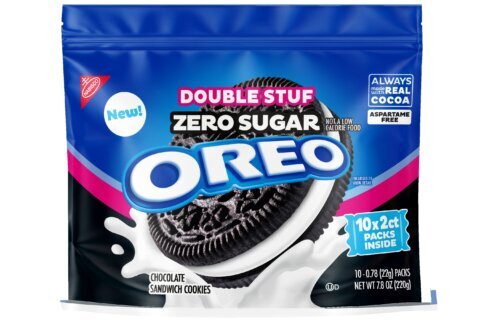


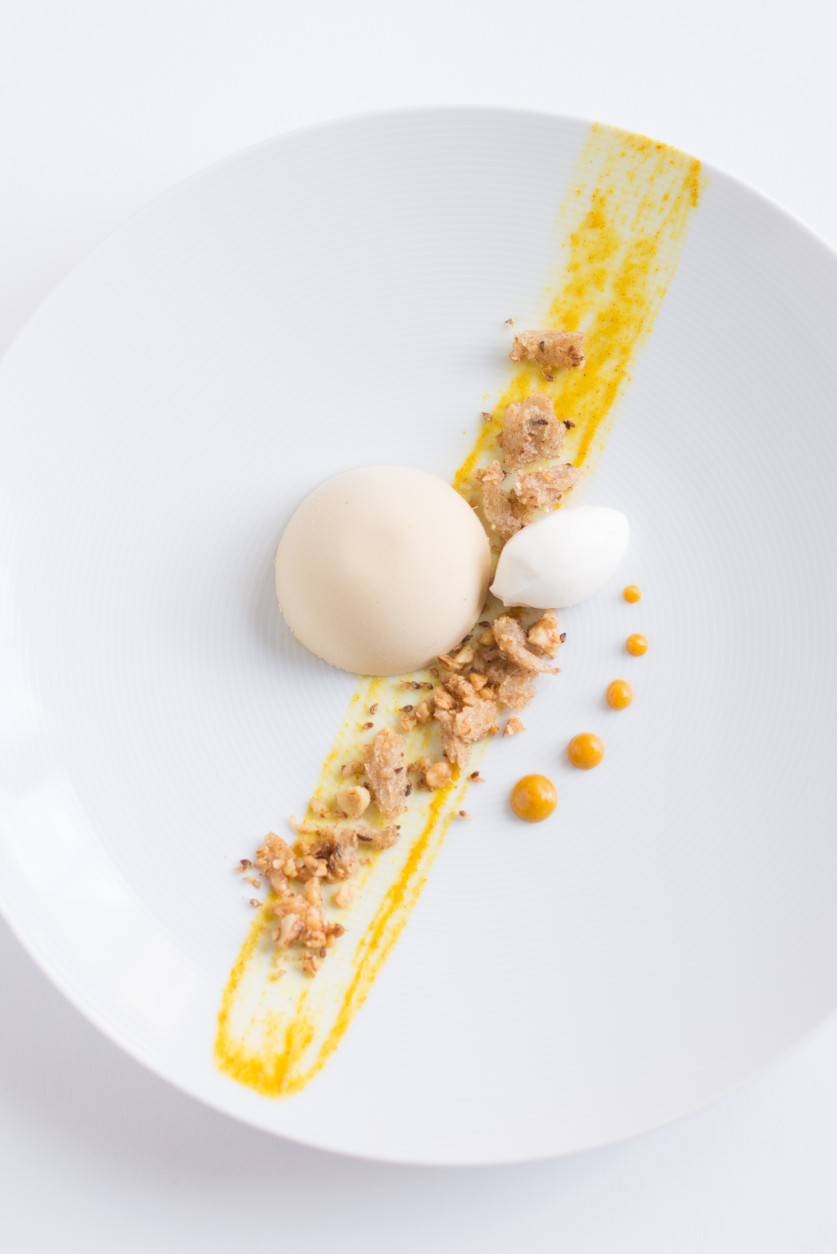


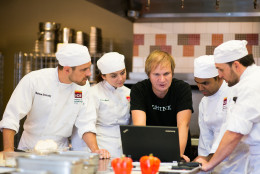
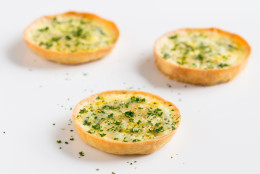
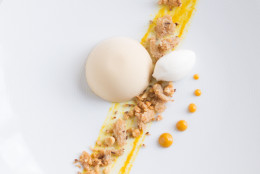

WASHINGTON — What do you get when you combine lean ground beef, chocolate, orange zest, cinnamon, apricot purée, edamame and a healthy handful of cheese over medium-high heat?
The filling for an Austrian chocolate burrito.
It may sound like a snack for the daring — or drunk — but the unlikely assortment of ingredients is both flavorful and palatable.
Just don’t take the chef’s word for it — he has no taste buds. In fact, Chef Watson is just a computer. But he’s revolutionizing the way professional chefs and at-home cooks are churning out dinner.
From Jeopardy to Jambalaya
In 2011, IBM successfully demonstrated that a computer can understand language, process information and respond to human prompts when Watson, a cognitive computer system, defeated two world champions in Jeopardy.
After the win, IBM researchers and scientists decided to extend Watson’s capabilities beyond processing information and generating responses. They wanted to build a system capable of creating new concepts and inspiring new ideas.
“Some people feel that the crowning achievement of human intelligence is our ability to be creative and come up with new things that have never been seen before,” says Steve Abrams, an IBM distinguished engineer and director of Watson Life.
So IBM took Watson out of the Jeopardy’s hot seat and into the heat of the kitchen.
The result is Chef Watson, a cognitive computer system that uses stored culinary information, including 10,000 kitchen-tested recipes published by Bon Appétit, and a series of algorithms to generate unique and original recipes — making it the perfect tool for those tired of eating the same thing for dinner.
“Because of the super-critical role that food plays in our lives — it’s such an important part of our social and cultural fabric; it’s sustenance; it’s something we need to survive — the thought was to try to pursue this idea of computational creativity in the domain of the culinary arts,” Abrams says. “It was built … to really inspire us to discover things that have never been seen before.”
Apple Pie from algorithms
Abrams says Chef Watson learned three major things after digesting the 10,000 recipes it reviewed: ingredients that are typically used together, factors that differentiate regional cuisines and basic ingredients that build a dish.
“It knows … the types of ingredients that you need to bring together to make a burrito are very different from what you might need to bring together to make soup. So it’s learned about combinations, cuisines and dishes,” Abrams says.
In addition, Chef Watson can recall information even the most seasoned chefs have difficulty retaining: It understands the underlying chemical compounds of ingredients.
“So it knows the molecular flavor compounds and how people respond to them through a pleasantness spectrum through some studies in the field of hedonic psychophysics,” Abrams says. “It can … generate combinations of ingredients that should go well with each other, should be pleasant to us, should be surprising, and, because they’ve never been used before, can meet the constraints of a chef.”
A Chef Watson user types in a main ingredient into the program, such as chicken, lobster or eggplant. The cook can then refine the search parameters by narrowing the specific region of the world from which the recipe comes. The end result is a list of unique ingredient combinations and recipes.
“It changes the way they think about bringing ingredients together and pairing ingredients to create new dishes. It’s like every dish that Watson presents to them is a puzzle that forces [users] to get out of the box, out of their comfort zone and think differently about how to create,” Abrams says.
Cooking as a collaboration
Chef Watson may help chefs think outside the recipe box, but it doesn’t run the kitchen. Abrams says it’s all about the collaboration between man and machine.
“Watson’s not taking into consideration the colors and the textures to make a beautiful presentation; that’s really in the hands of the chef,” Abrams says.
In other words, Chef Watson lends a hand where humans are limited, and humans help where the computer cannot.
Bon Appétit recently challenged its readers to develop a tomato-themed dish using Chef Watson. A reader who made a spicy tomato gazpacho found that while Watson’s flavor-pairing combinations were on-par, the computer-generated recipe fell short in presentation.
The reader adjusted the recipe so that the avocado was chopped and served on top of the gazpacho, rather than blended in with the ingredients, and found success.
“We’re not all able to read all of the latest published material in any given field — that’s something that Watson can do. But Watson can’t apply our judgments or our aspirations in the way that a human being can, so we really need to bring the two together so that together the human and the computer can create more than either one would have been able to create on their own,” Abrams says.
Chefs at the Institute for Culinary Education, a partner in the Chef Watson project, were surprised when the system recommended using strawberries and mushrooms in an apple kebab dish, but gave it a try anyway.
“It turns out that strawberries and mushrooms share a number of flavor compounds … and the flavors really harmonized quite nicely,” Abrams says.
Watson is currently being beta tested by thousands of users (in fact, you can test it yourself), but some of its most successful combinations are available in the new cookbook “Cognitive Cooking with Chef Watson.” The book features 65 recipes developed in partnership between the Watson system and the chefs at the Institutes of Culinary Education.
IBM’s Abrams says Chef Watson’s abilities in the kitchen are just the tip of the iceberg of what cognitive computer systems can tackle. Similar technology is being used in the pharmaceutical, medical and judicial fields. It can be applied to any domain where the creative process is dependent on science, research or history.
“I think in the future we’re going to see more areas where humans and computers are going to be collaborating to come up with new insights,” Abrams says.
“We think that people who are really interested in pushing their creative boundaries and finding new combinations and really at the leading edge of discovering new ingredient combinations in new dishes are going to find this very interesting.”
Want to give Chef Watson’s creative combinations a try? Try the recipe below.
—
Recipe: Indian Turmeric Paella
James Briscione
This recipe brings simple Indian flavors to a classic paella preparation. While Chef Watson didn’t suggest adding any seafood to this particular dish, I can imagine that shrimp and/or mussels would be most welcome. Take care when toasting the spices in each step, as this is the key to optimal flavor in the finished dish.
Pro Notes and Tips: The crispy layer of rice that forms on the bottom of the pan is called “socarrat,” and is always the part everyone fights over. To achieve it, continue cooking after all the liquid has been absorbed to crisp the rice, but keep a careful eye and the heat low to avoid scorching it.
SMOKED HAM HOCK STOCK
- 1 pound (500 grams) smoked ham hocks
- 1 pound (500 grams) beef chuck, cubed and seared
- 1 quart (1,000 grams) vegetable stock
- 2 sprigs (6 grams) fresh mint
- 2 branches (30 grams) fennel greens
Place the ham hocks, chuck, vegetable stock, mint and fennel greens in a pressure cooker. Bring to pressure over medium heat and cook for 1 hour.
Strain the stock and reserve.
Remove the skin and bones from the ham hocks, cut the meat into chunks and reserve. Pull the beef into large pieces — do not shred — and reserve.
PAELLA
- ¼ cup (50 grams) clarified butter
- 10 cardamom pods
- 1 branch (2 grams) fresh curry leaves
- 1 cup (165 grams) Idaho potato, diced
- 1 whole (65 grams) poblano pepper, diced
- 1 cup (115 grams) fennel bulb, diced
- 5 cloves (20 grams) garlic, chopped
- 2½ cups (450 grams) bomba or Arborio rice
- 1 teaspoon (3 grams) turmeric
- 1 tablespoon (8 grams) curry powder
- ½ teaspoon (1 gram) nutmeg, grated
- ¼ cup (50 grams) light rum
- 1¼ cups (300 grams) ham hock stock
- 2½ cups (600 grams) vegetable stock
- Kosher salt, as needed
- Cherry tomatoes, halved, for garnish
DIRECTIONS
Heat the butter in a paella or large nonstick saute pan. Add the cardamom and curry leaves. Cook until lightly browned and very aromatic. Add the potatoes and sauté for one minute. Add the poblano and fennel, sauté one minute. Add the garlic and cook.
Stir in the rice, turmeric, curry powder and nutmeg. When the rice is well toasted, deglaze the pan with rum and cook until completely dry.
Add the stock and meat. Stir well and season to taste with salt. Bring the mixture to a boil, then reduce the heat and simmer approximately 20 minutes (until all of the liquid has been absorbed and the rice on the bottom of the pan begins to brown).
To serve, top the paella pan with the cherry tomatoes, green mango salad and fried spinach (recipes to follow).
GREEN MANGO SALAD
- ½ green mango (100 grams), julienne
- 2 teaspoons (10 grams) lime juice
- 2 tablespoons (20 grams) green anaheim chile, thinly sliced
- 1 tablespoon (10 grams) fresh mint, chopped kosher salt, as needed
Combine the mango, lime juice, chile and mint. Mix well and season to taste with salt.
CRISP SPINACH
- 1 cup vegetable oil
- 1 cup baby spinach
Heat the oil in a saute pan to 350˚F. Add the spinach and cook, stirring gently until crisp. Remove immediately and drain on paper towels.



